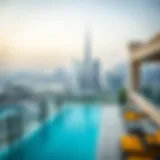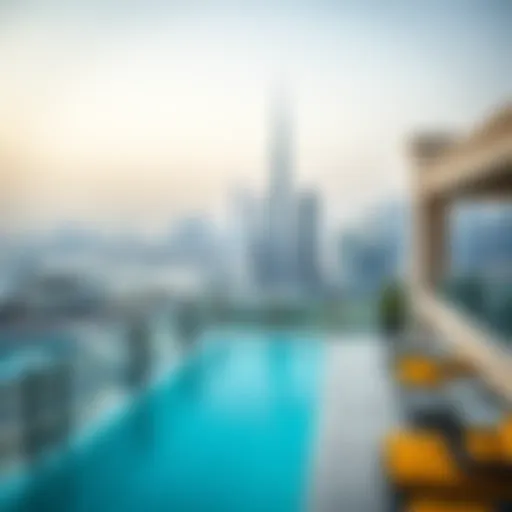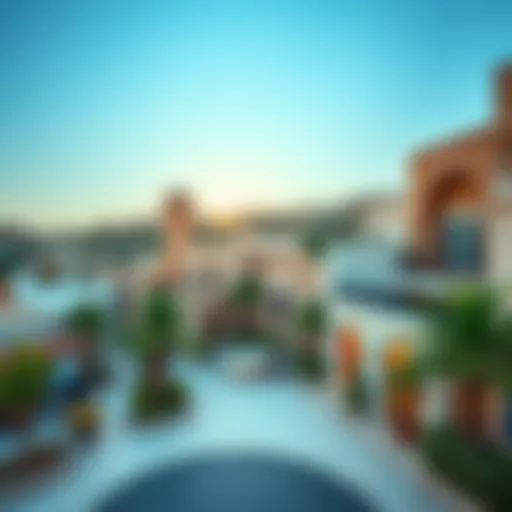Noteworthy Tourist Attractions to Explore in Dubai
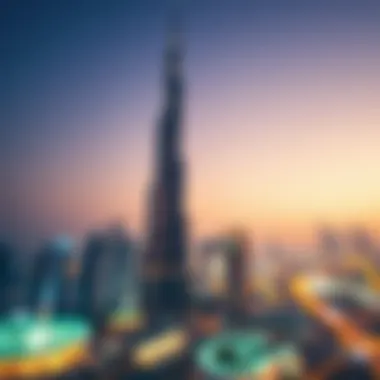
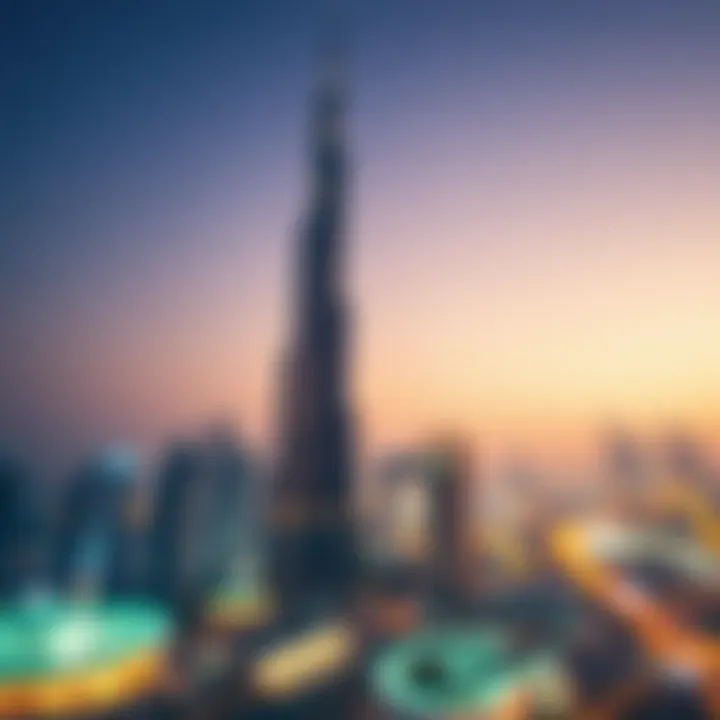
Intro
Dubai stands as a beacon of luxury within the desert, where cutting-edge architecture coexists seamlessly with rich history. Every corner of this vibrant city presents an opportunity for discovery—from the sparkling waters of the Persian Gulf to the intricate designs of ancient souks. As an investor, understanding the landscape of tourist attractions in Dubai offers more than just a glimpse into culture; it reveals the heartbeat of the city's real estate market. In essence, the very foundations of these attractions contribute to their surroundings, influencing property values, developments, and trends.
Dubai’s skyline is dotted with stunning landmarks such as the Burj Khalifa, the world's tallest building, and the Palm Jumeirah, a feat of engineering that draws visitors from across the globe. These landmarks do not merely serve as tourist destinations; they encapsulate the spirit of Dubai and directly impact market demand in their vicinity.
This article aims to equip property enthusiasts and investors with a thorough understanding of key tourist attractions throughout Dubai, exploring their historical significance, architectural excellence, and cultural impact. Throughout our journey, we will uncover how these treasures relate to the broader real estate landscape, offering insights into property values and potential investment returns.
Let’s delve into the initial domain of property trends to set the stage for an informed exploration of all that Dubai has to offer.
Prolusion to Dubai's Tourist Landscape
The tourist landscape of Dubai is an intricate tapestry woven with threads of innovation, culture, and tradition. This dynamic city has become a magnet for globetrotters seeking luxurious experiences, yet it continues to embrace its rich heritage. Understanding the breadth and depth of Dubai's attractions is essential, especially for investors, homeowners, and developers who want to grasp how these landmarks impact the real estate market. Each sight serves a dual purpose: as a draw for visitors and a contributor to the community's economic fabric.
Overview of Dubai's Rapid Development
Once a modest fishing village, Dubai has transformed at a breakneck pace. With skyscrapers slicing through the clouds and lavish malls lining the streets, the city is a testament to modernity. Within just a few decades, what was once a arid backdrop of sand has emerged into a global hub for tourism and business—offering a vibrant mix of opportunities. This rapid advancement has created a booming real estate market, enticing investors looking to purchase prime property near bustling attractions.
The city’s journey reflects its ambitious vision. Many cannot fathom how swiftly Dubai evolved, yet the commitment to innovation is palpable in every corner.
The Fusion of Tradition and Modernity
Dubai exemplifies a unique blend of the old and the new, making it one of the most compelling destinations in the world. Traditional souks, where you can purchase spices and textiles, stand in close proximity to modern marvels like the Burj Khalifa and the Dubai Mall. This juxtaposition enriches Dubai’s cultural identity, allowing visitors to engage with the past while enjoying the luxuries of the future.
Wandering through the Al Fahidi Historical Neighborhood, one feels transported back in time. The narrow lanes and wind-tower architecture tell a story of a simpler life that contrasts sharply with Dubai's current landscape. The city has managed to protect these historical sites amid relentless development, showcasing a firm grasp on its roots. Investors and developers must pay heed to this balance; understanding that real estate investment thrives in areas that honor both tradition and state-of-the-art conveniences.
"Dubai offers a unique experience that appeals to everyone, whether they're drawn by its rich history or cutting-edge advancements."
While glitz and glamour play a significant role in attracting tourists, it is the city's ability to retain its heart and soul that keeps visitors returning. The tales of the past enrich the experience of the present, making Dubai a fascinating intersection of history and modernity.
Iconic Landmarks
When one thinks of Dubai, certain landmarks immediately spring to mind. These iconic structures are not just constructions of steel and glass; they encapsulate the essence of what Dubai represents. In terms of tourism and investment, iconic landmarks hold a unique significance. They attract millions of visitors every year and stand as a testament to modern engineering, creativity, and artistry. Moreover, they play a pivotal role in driving the real estate market, showing how physically monumental structures can sometimes reflect the economic landscape of a city.
Burj Khalifa: The Pinnacle of Architectural Achievement
History and Construction
Constructed within a decade, the Burj Khalifa's journey started in 2004 and reached its peak in 2010. Standing at 828 meters tall, it's the tallest building in the world, and the result of ambition fueled by advanced engineering practices. One of the key characteristics of its construction is the use of a unique reinforced concrete core, which ensures stability against natural elements, and the approach to achieving such heights is nothing short of groundbreaking. This iconic tower is a beneficial point for this article because it signals Dubai's rapid transformation. The challenges faced during its construction, like securing funding and addressing safety measures, showcase the kind of determination that separates Dubai from many places around the globe. Those curious about architecture or engineering will find the Burj Khalifa an engaging subject, as it is not just about the heights but about innovative engineering methods employed in its building.
Visitor Experience
The visitor experience at the Burj Khalifa is quite extraordinary. On the 148th floor, observation decks offer spectacular views stretching as far as the eye can see. One can't help but feel small standing at such heights, looking down on the sprawling city below. A unique feature is the “At the Top” experience, which allows visitors to ascend to this lofty height and drink in the Dubai skyline. This experience tends to demand a good chunk of change, but the memories made at such a height linger long after one comes back down. It’s a must for travelers and investors alike; the Burj Khalifa acts as a magnet, drawing in visitors not only for its charm but also for its real estate advantages in the surrounding areas.
Palm Jumeirah: An Artificial Archipelago
Design and Development
Palm Jumeirah is an engineering marvel and a brilliant example of modern urban planning. The design mimics a palm tree, characterized by a trunk and 17 fronds, surrounded by a crescent barrier. Its development opened the door to luxurious living along its shore, transforming the coastline of Dubai. This project is significant as it symbolizes Dubai’s ambition to reshape its identity, pushing boundaries of what urban living can look like. The environment created by Palm Jumeirah is attractively designed not just for aesthetics but functionality too. Property developers eye this area with a keen interest because real estate here has shown a consistently high return on investment. This is essential information for potential buyers and investors looking for opulent locations with a sea-view guarantee.
Real Estate Implications
The real estate implications of Palm Jumeirah cannot be overstated. Properties here rank among the most coveted in Dubai, with prices often reflecting the luxury associated with the location. Notably, residences on the fronds offer breathtaking views of both the Arabian Gulf and the Dubai skyline. This duality enriches the locale, creating a desirable market for high-net-worth individuals. Buyers often consider Palm Jumeirah for its status rather than merely as a place to live. As such, high property values traditionally correlate with the prominence of the landmark itself, making it an essential component of any investor's portfolio. However, potential buyers should be aware of implications like maintenance costs and regulations that apply primarily to properties in such elite developments.
Burj Al Arab: The Symbol of Luxury
Architectural Marvels
The Burj Al Arab stands as a beacon of luxury, often regarded as the most photographed hotel globally. It’s designed in the form of a sail, its silhouette dominating the skyline. Opened in 1999, its distinctive shape and a height of 321 meters make it a standout feature on the waterfront. The luxury it embodies isn’t solely in its heights or its extravagant design, but also in the meticulous attention to detail that went into every aspect of its creation. This architectural wonder is integral to understanding Dubai’s real estate market since hotels of this caliber significantly enhance tourism. As a result, they drive demand for high-end properties, particularly in surrounding areas. For those dabbling in property investments, it reveals how the essence of luxury translates into economic advantages.
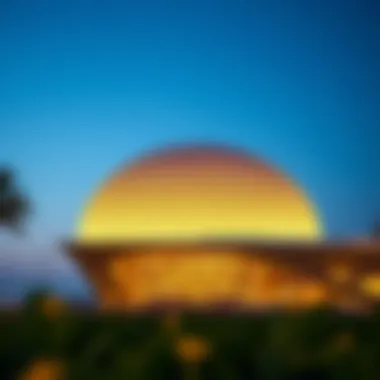
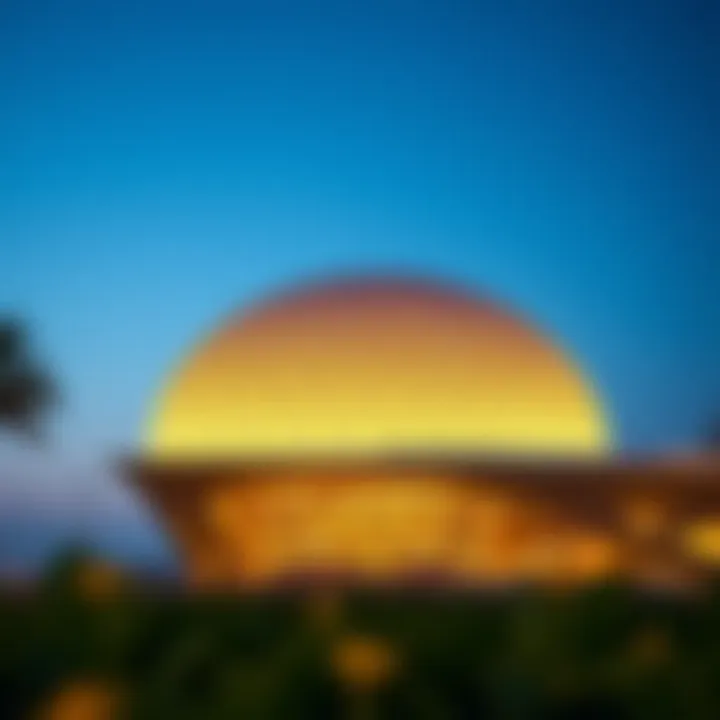
Hospitality and Services
What truly sets Burj Al Arab apart is the unparalleled hospitality it provides. With a staff-to-room ratio that is one of the highest in the world, every guest experiences tailor-made luxury from the moment they step into the hotel. Noteworthy features include a private beach, helipad, and even a ski slope within its confines—which leaves potential visitors in awe. This level of service has cemented Burj Al Arab’s reputation as the epitome of high-class accommodation, making it essential for anyone looking to understand the tourism landscape in Dubai. However, the premium rates might dissuade some travelers, making it accessible primarily for a niche market.
Burj Al Arab does not just represent luxury; it serves as a critical player in the tourism-driven real estate ecosystem, highlighting how attractions affect property values and investments.
These landmarks are far more than mere tourist sites; they represent the heartbeat of a city that merges historical significance with modern luxury, portraying a dynamic environment for investment and development.
Cultural and Historical Sites
Understanding the cultural and historical sites in Dubai provides a crucial insight into how the city blends its rich past with its modern ambitions. These sites serve not only as windows into the heritage that shaped the Emirates, but also as pivotal markers in the ongoing story of Dubai's evolution. Visitors who land in this bustling hub should take a detour into its past to appreciate fully its rapid ascent into a global icon.
Dubai Museum: A Glimpse into the Past
Exhibits and Significance
The Dubai Museum, located in the heart of the city, is housed in the historic Al Fahidi Fort, built against the backdrop of 1787. This venue provides a lens through which one can observe Dubai's transformation from a small fishing village to a thriving metropolis. Exhibits here capture the essence of local culture, featuring life in Dubai before the oil boom. A notable characteristic of the museum is its use of traditional artifacts, such as old maps, weapons, and daily life items, that illustrate the simple yet profound lifestyle of the past.
Visitors are often surprised by how interactive the displays are. The life-size dioramas showing market scenes and local trade showcase the bustling atmosphere of pre-modern Dubai, making it an attractive spot for history buffs and casual tourists alike. However, one might struggle to find extensive English translations for all exhibits, which may limit the experience for some international visitors.
Visitor Information
The Visitor Information at the Dubai Museum is particularly user-friendly, making it a top notch destination for all. There’s a rather easy-to-navigate layout and staff are usually on hand to assist, enhancing the overall experience. The museum also provides guided tours that are both affordable and informative, allowing guests to delve deeper into the artifacts on display. Unlike many modern attractions, entry fees are quite low, which adds to its allure as a budget-friendly option.
However, it can get crowded during weekends, so timing your visit may be key. Also, working hours might change during holidays, so checking ahead will ensure a smooth experience.
Al Fahidi Historical Neighborhood: Preserving Heritage
Architecture and Layout
The Al Fahidi Historical Neighborhood offers one of the best-preserved areas of traditional Emirati architecture in Dubai. The wind-tower structures, with their unique designs aimed at natural ventilation, stand as testaments to the ingenuity of local masons long before air conditioning was a thought. Exploring the narrow alleyways feels like stepping back in time; the craftsmanship and the layout of the district resonate with an authenticity that many newer areas lack.
This district is often favored for its intimate ambiance and aesthetic appeal, making it a great backdrop for photography. One distinct advantage is the abundance of cultural cafes where visitors can sip Arabic coffee while enjoying the tranquil surroundings. Though, the district might require a considerable amount of walking, which could be a disadvantage for those with mobility issues.
Art Galleries and Cultural Events
Al Fahidi hosts numerous Art Galleries and Cultural Events, which elevate its status as not only a heritage site but also a contemporary cultural hub. With galleries showcasing local talent alongside international artists, it's a thriving hub for art lovers. An additional highlight is the annual events that gather artists, musicians, and performers, offering enriching experiences for both locals and tourists.
Art events here often push the envelope, encouraging dialogue between cultures while promoting understanding through creativity. This neighborhood's unique blend of art and tradition is an appealing element that draws a diverse crowd. Yet, accessibility can sometimes be a hiccup during major events as crowds tend to swell, making it a little more chaotic than one might prefer.
By immersing in these sites, tourists create connections that transcend mere observation; they engage in the living narrative of Dubai—one that intertwines tradition with its dynamic future.
Entertainment Attractions
When you think about Dubai, the glittering skyline and luxurious lifestyle come to mind. However, the true heartbeat of this vibrant city lies in its entertainment attractions. These hotspots not only cater to tourists but also enhance the overall living experience for residents and property investors alike. Cultural highlights, shopping extravaganzas, and thrilling adventures are all part and parcel of what Dubai offers. As the city continues to evolve, these attractions become even more crucial, creating a symbiotic relationship between tourism and real estate.
Dubai Mall: A Retail and Entertainment Haven
Shopping Experience
Dubai Mall stands as a beacon for shopping lovers, and its contribution to the entertainment landscape is monumental. With over 1,200 retail stores, it is a shopper's paradise. This vast selection ensures that there is something for everyone, from high-end designers to local crafts. The mall’s unique feature, the Dubai Aquarium, draws in crowds, providing an extraordinary experience even before they dive into the shopping.
Visiting Dubai Mall means immersing oneself in a world that balances shopping with adventure. Shoppers often find themselves entertained by light shows and live performances scattered throughout the mall. This dynamic environment makes it a key attraction for visitors as well as a vital contributor to the local economy. The rental spaces here are often in high demand, reflecting the mall's influence on the surrounding real estate market.
Leisure Activities
Beyond shopping, leisure activities at Dubai Mall elevate the visitors’ experience. Whether it’s ice skating at the Olympic-sized rink or enjoying a meal with stunning views of the Burj Khalifa, the leisure offerings are diverse. Unique features like the VR Park provide exciting virtual reality experiences that appeal to both locals and tourists.
The blend of relaxation and thrill makes these leisure activities a significant draw for families, especially during weekends. It’s not just about spending money but creating memories. Families value the mall as a safe and entertaining space, influencing their decisions on where to invest in property given its family-friendly appeal.
IMG Worlds of Adventure: A Theme Park Extravaganza
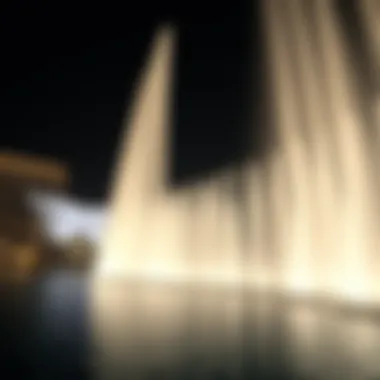
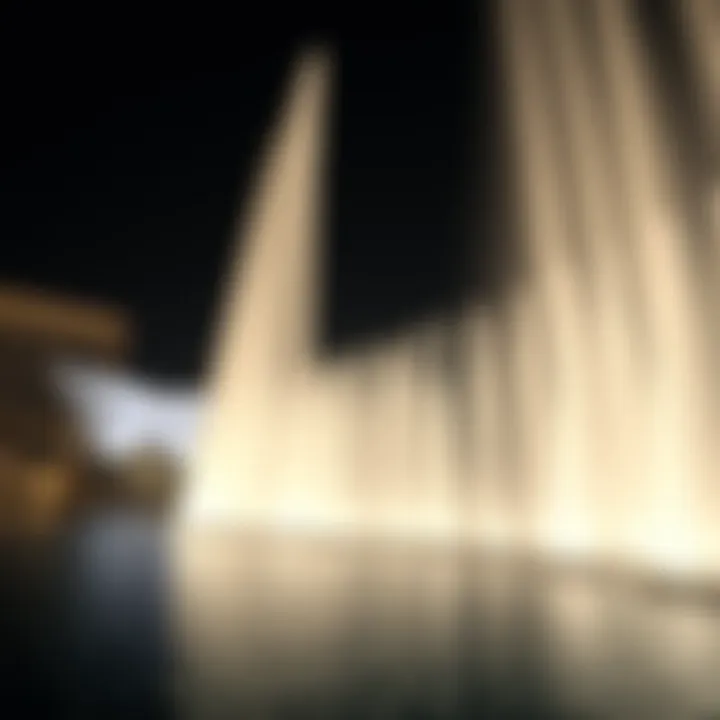
Attractions Overview
IMG Worlds of Adventure is a platform for escapism where themes come to life. As one of the largest indoor theme parks in the world, it offers a variety of attractions that cater to different age groups. The park’s distinct zones, such as Marvel and Cartoon Network, provide immersive experiences that captivate visitors.
What sets IMG apart is its sheer size and the variety within it. From thrilling roller coasters to kid-friendly attractions, it’s designed to entice anyone seeking adventure. This theme park has a significant impact on the local economy by attracting families and thrill-seekers, heightening the demand for nearby real estate developments.
Visitor Tips
For those planning a trip to IMG Worlds of Adventure, a few handy tips can enhance the experience significantly. Start your visit early to beat the crowds, especially during peak seasons. It’s advisable to check show schedules beforehand to catch live performances without missing out on key attractions.
Additionally, consider purchasing express passes if you want to avoid long wait times for rides. Making the most of your visit could potentially influence your future investment decisions. Properties near attractions like IMG Worlds are primed for value appreciation, particularly since they appeal to families looking for fun and entertainment.
In summary, Dubai’s entertainment attractions like Dubai Mall and IMG Worlds of Adventure enrich the city’s tourism landscape, making them key to understanding the relationship between leisure and real estate. Whether you’re an investor, a developer, or a resident, these destinations play a pivotal role in shaping the city's character and economic viability.
Natural Attractions
Natural attractions play a vital role in enhancing Dubai's appeal. It's not just about the towering skyscrapers and luxurious malls; the natural landscapes offer a stark contrast that complements the modern urban development. These spots provide respite from the buzzing city life, offering visitors a chance to rejuvenate amid serene environments. The distinct elements of these attractions contribute significantly to the overall allure of the city, inviting tourists and investors alike to explore the nuances of Dubai’s ecological treasures.
Desert Safari: An Adventure Beyond the City
Safari Details
Desert safaris in Dubai stand out as a key experience, showcasing the vast expanse of the Arabian desert. This exhilarating adventure lets visitors feel the thrill of 4x4 vehicles gliding over sand dunes, a true test of both speed and agility. One major draw is the unique chance to witness traditional Bedouin culture up close. The experience often includes activities like camel riding, sandboarding, and even a taste of local cuisine around a campfire.
The unique feature of desert safaris is their ability to blend adventure with cultural immersion. However, it's worth noting that these excursions can vary in quality, making it essential for visitors to choose reputable operators. Travelers find it beneficial due to the shared experiences and breathtaking sunsets that linger long in memory, but it can also seem daunting for those unaccustomed to the open desert environment.
Local Wildlife
The wildlife of the Arabian desert is another intriguing aspect of a desert safari. The region is home to various species such as the Arabian oryx and sand gazelles, which have adapted to thrive in these harsh conditions. Witnessing these animals in their natural habitat fosters a deeper appreciation for the ecological balance and the importance of conservation efforts. The key characteristic of local wildlife is its rarity and unique adaptation. This factor makes it a popular choice, particularly among wildlife enthusiasts and photographers. However, it’s essential to approach wildlife viewing respectfully, ensuring the safety of both animals and visitors. The chance to observe this distinct ecosystem can be thrilling, but awareness of environmental issues remains crucial in protecting these species.
Dubai Creek: The Heart of the City
History of the Creek
Dubai Creek serves as a lifeline in the city, rich with history and cultural significance. Once a modest fishing and pearling site, it has evolved into a vibrant hub connecting various neighborhoods and communities. This historical waterway has witnessed the transformation of Dubai from a trading port to a global metropolis. Many still utilize traditional abra boats to cross the creek, keeping the history alive in daily commutes. The creek's unique feature is its ability to narrate the tale of Dubai’s growth, making it a fascinating choice for tourists and investors looking to understand the city’s lineage. This blend of historical depth and modern development adds layers to Dubai's identity, appealing to those who appreciate both past and present.
Impact on Real Estate
The impact of Dubai Creek on real estate is significant. Properties in close proximity to the creek, especially with waterfront views, tend to command premium prices. This area has seen a surge in development, with upscale residential and commercial buildings sprouting along its banks, enhancing the city's skyline. The creek's unique feature of being both a historical landmark and a developing region appeals to investors and homeowners alike. The relationship between the creek and real estate is beneficial, as its proximity often increases property values. However, this can also lead to challenges such as overcrowding and development pressures, prompting discussions about sustainable growth within the city. Investors looking at properties near the creek often find a blend of rich cultural heritage and modern amenities, ensuring a promising market.
In summary, the natural attractions of Dubai, including desert safaris and Dubai Creek, underscore the city's narrative, from its historic roots to its modern ascent. These elements not only enrich the tourist experience but also significantly influence the real estate landscape, making them pivotal for understanding Dubai's holistic appeal.
For further information, consider visiting resources such as Wikipedia and Britannica.
Modern Architectural Wonders
Dubai stands as a testament to human creativity and ambition, particularly visible in its modern architectural wonders. These structures are not just buildings; they encapsulate the spirit of innovation and aspiration that define the city. Their significance extends beyond aesthetics, serving vital roles in property value enhancement and urban planning. As investors and developers closely monitor these landmarks, their influence on the real estate market becomes clear. This segment delves into two iconic examples, The Frame and the Dubai Opera, examining their design, construction, visitor perspectives, and cultural impact.
The Frame: A Unique Perspective
Design and Construction
The Frame creates a striking visual representation of Dubai's quest for balance between tradition and futurism. Its design resembles a massive frame, standing at the unique height of 150 meters with a width of 93 meters, and it physically and metaphorically frames the city. Inspired by the art of photography, it offers vistas both of the past, through its lower area showcasing old Dubai, and the ongoing development in the surroundings.
A notable aspect of its construction is the use of high-performance glass and steel, making it not only an architectural marvel but also sustainable in energy efficiency. This combination contributes significantly to its appeal, as sustainability becomes a priority for modern investors. The open-air observation deck provides a panoramic view that highlights the dramatic evolution of Dubai’s skyline, reinforcing the idea of growth and continuity.
Visitor Perspective
From a visitor's standpoint, The Frame presents an experience that resonates on multiple levels. For tourists, it's not just about the views but also the narrative that intertwines the old and new. The immersive exhibits located on the ground floor educate visitors about Dubai's history and rapid development, creating a connection to the city beyond mere tourist attractions.
A unique feature is its interactive displays, which engage visitors in a way that few attractions do. However, it can be crowded during peak seasons, challenging the extent of personal experience. Overall, the balance of education, visual impact, and interactive engagement makes The Frame a prime attraction for those looking to grasp the essence of Dubai.
Dubai Opera: A Cultural Destination
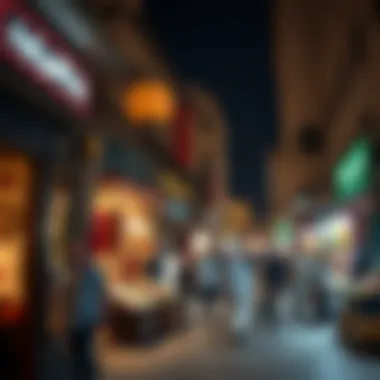
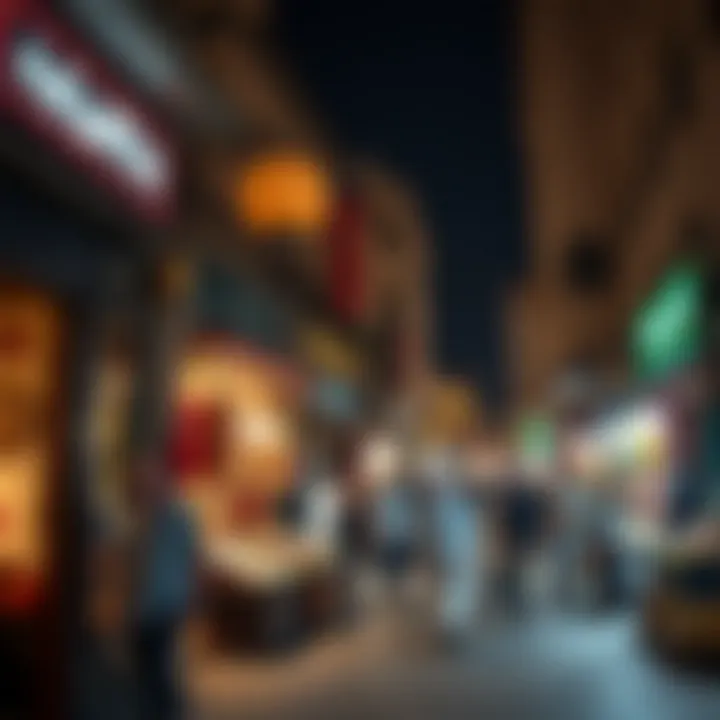
Architecture Overview
Like bird wings soaring into the sky, the Dubai Opera is a masterpiece of waterfront architecture. With its dhow-like structure, the building encapsulates the cultural heritage of the region while drawing a line toward future innovations in design. Spanning 1,800 square meters, this opera house is not only visually striking but acoustically remarkable, equipped with advanced sound technologies.
The architectural team made strategic choices to enhance the visitor experience. Its versatility allows the venue to host a variety of performances, from operatic productions to ballet and concerts. This multifunctionality broadens its appeal, making it a favored destination for cultural enthusiasts and boosting the city's profile as a cultural hub.
Events and Performances
The Dubai Opera is a lively center for various events, tailored to attract a diverse audience. From classical music to contemporary performances, its calendar is packed with activities that showcase local and international talents. For real estate investors, its continuous stream of events indicates a growing cultural sector that can increase nearby property values.
Notable features include seasonal festivals and themed events, offering something for everyone. However, experiencing a performance can require advanced booking due to high demand, which can be a limiting factor. Overall, the Dubai Opera not only entertains but also fosters a rich cultural exchange, adding depth to Dubai's architectural landscape.
The modern architectural wonders of Dubai do not merely stand tall; they resonate with the city's ambitions, desires, and cultural narratives, making them essential fixtures in understanding the city's real estate dynamics.
Shopping Destinations
Shopping in Dubai is not just a pastime; it is a vibrant experience that combines culture, luxury, and adventure. In this bustling metropolis, shopping destinations play a crucial role in drawing tourists and contributing to the city’s booming economy. These venues are not merely places to buy goods but are integral attractions that offer a mix of traditional and contemporary experiences. From large malls to quaint markets, shopping in Dubai showcases the diverse offerings that this city has for both tourists and locals.
Global Village: A Unique Shopping Experience
Attractions and Events
Global Village stands out as a true melting pot of cultures, providing visitors a chance to explore various international pavilions that each display unique offerings from around the world. Events like cultural performances, fireworks, and themed festivals add a layer of excitement, turning a simple shopping spree into an engaging experience. The allure of Global Village lies not only in shopping but also in the myriad of activities that appeal to all senses. It draws families looking for entertainment while also attracting keen shoppers who seek competitive prices on unique products.
This vibrant environment offers numerous food stalls serving regional cuisines, providing a taste of global flavors without stepping foot outside Dubai. However, it's important to note that the popularity of this destination can lead to crowded days, which may detract from the shopping experience for some.
Shopping Overview
At Global Village, one can find a wide array of products ranging from handcrafted items to textiles at reasonable prices. The uniqueness of these items lies in their artisanal value, often sourced from local craftspeople. This aspect makes shopping here distinctive and enjoyable. Additionally, the concept of cultural integration through shopping makes it an appealing choice for tourists looking for souvenirs that capture the essence of their visit.
While the pricing is generally more competitive compared to high-end malls, visitors should be aware that quality can vary. Items that are priced lower may not always meet the high standards commonly found in luxury retail outlets.
Souk Madinat Jumeirah: Traditional Market with Modern Flair
Design and Atmosphere
Souk Madinat Jumeirah seamlessly blends old-world charm with contemporary comforts. The architecture evokes traditional Arabian styles, characterized by winding alleyways and canals, creating a sense of entering a different time era. The atmosphere is alive with the sound of water features and the scent of spices, making it a feast for the senses.
This setting is particularly advantageous for tourists who appreciate a richer cultural backdrop as they shop. The lighting, vendors’ stalls, and lush landscaping contribute to an inviting environment, perfect for a leisurely stroll. Though picturesque, visitors should note that it tends to be less bustling than Global Village, offering a calmer shopping experience but potentially fewer exciting events.
Shopping and Dining Options
Within Souk Madinat Jumeirah, one can find various boutiques offering everything from handcrafted jewelry to luxurious Arabian goods. This market excels in providing high-quality items that reflect the region’s artistry, which serves well anyone wanting to take a piece of Dubai back home. Moreover, the dining options available range from casual eateries to upscale restaurants, enhancing the shopping experience.
While the charm and quality of options are undeniable, prices may lean towards the higher end compared to other shopping venues. This is a trade-off for the ambiance and product uniqueness that Souk Madinat Jumeirah offers, making the overall experience quite rewarding.
In essence, shopping destinations in Dubai are not solely about purchases; they foster a deeper connection to the culture, craftsmanship, and commerce of this remarkable city.
The End
In concluding our exploration of Dubai's tourist attractions, it’s crucial to recognize the significant interplay between tourism and real estate in this glimmering city. Each landmark, from the majestic Burj Khalifa to the bustling souks, contributes not just to the cultural fabric of Dubai but also compellingly influences its property landscape. When investors and developers eye potential growth areas, these attractions are often at the forefront of their considerations.
The Relationship Between Attractions and Real Estate
The correlation between tourism hotspots and the local real estate market can be likened to two sides of the same coin. High tourist traffic creates energy and demand, which in turn elevates real estate values. For instance, consider how properties near the Dubai Mall or the Dubai Opera tend to attract higher rental prices. Investors know that proximity to such iconic sites increases desirability among potential tenants and buyers alike. Additionally, as word spreads about exciting attractions or newly launched experiences, nearby areas often experience a surge in property interest.
When tourist footfall rises, the ripple effect can be seen across related sectors. Retail businesses thrive, restaurants fill up, and, as a result, the overall economic landscape experiences positive momentum. With projects like Dubai Creek Harbour and Expo 2020 focusing on integrating vibrant tourist experiences within residential and commercial developments, the relationship between these attractions and real estate becomes even more pivotal.
In today’s market, savvy investors observe these trends to predict growth. The pull of major attractions often serves as a compass steering buyers toward lucrative investment opportunities in Dubai.
Final Thoughts on Dubai's Tourist Appeal
Dubai’s allure as a travel destination lies not only in its exceptional landmarks but also in its commitment to creating a rich tapestry of cultural and recreational experiences. Each attraction narrates a story—from the innovations in architecture evident in the Burj Al Arab to the historical depth found at the Dubai Museum. This blend gives visitors a profound understanding of the region's diverse heritage while drawin in modern amenities.
Importantly, the city's adaptability to global trends—be it through luxurious escapades, cultural festivals, or cutting-edge technology—ensures that Dubai continues to attract both tourists and potential investors.
As we wrap up, it’s evident that Dubai's dynamic tourist environment opens avenues for a thriving real estate market. Investors and homeowners seeking to stake their claims in this bustling metropolis will find that understanding the connections between these attractions and property values is key to making informed decisions. Ultimately, the city stands as a testament to what happens when historical reverence meets futuristic vision, creating an ecosystem where every attraction enhances not just the tourism experience but also the real estate landscape.
